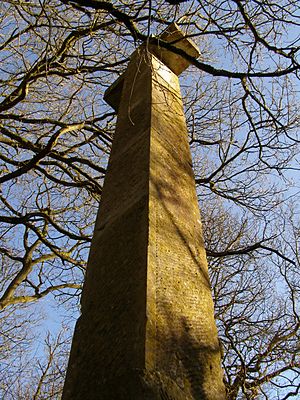Dead Man's Plack facts for kids

Illustration from Dead Man's Plack and an Old Thorn by William Henry Hudson
|
|
| Coordinates | 51°12′04″N 1°25′39″W / 51.2012°N 1.4275°W |
|---|---|
| Location | Longparish, Hampshire, England |
| Type | Cross |
| Material | Stone |
| Completion date | 1825 |
| Dedicated to | Earl Athelwold of Wherwell |
The Dead Man's Plack is a stone monument built in the 19th century. It is located in Harewood Forest, near Longparish, in Hampshire, England. This monument is linked to an old legend about Æthelwald, Ealdorman of East Anglia. The story says that King Edgar I killed Æthelwald here in 963 AD. This happened because of a love rivalry.
However, the name "Dead Man's Plack" probably comes from something else. It might be a changed version of "Dudman's Platt." This refers to a person named Dudman who lived there in 1735. "Platt" means a piece of land. The monument was put up in 1825 by Lt. Col. William Iremonger.
Contents
What Does It Look Like?
The Dead Man's Plack is a simple stone cross. It stands on a stone base, called a pedestal. There are no fancy carvings on it.
On one side of the monument, there is an old-style inscription. It tells the legend of King Edgar and Earl Æthelwald. It says that around the year 963 AD, King Edgar killed Æthelwald on this spot. The legend claims Æthelwald was a trusted friend who betrayed the King. He supposedly married the beautiful Ælfthryth, who King Edgar had planned to marry. Ælfthryth later became King Edgar's wife and the mother of King Ethelred II. The inscription also mentions that Queen Ælfthryth later founded a nunnery at Wherwell.
On the other side of the monument's base, another inscription says: "This Monument was erected by Col William Iremonger AD MDCCCXXV." This means Colonel William Iremonger built it in 1825.
The Legend of King Edgar and Æthelwald
The legend tells a dramatic story. King Edgar I wanted to find a suitable wife. He sent his most trusted earl, Æthelwald, to meet a woman named Ælfthryth. She was the daughter of the Earl of Devonshire. Æthelwald's job was to see if she would be a good queen.
But when Æthelwald met Ælfthryth, he was amazed by her beauty. He fell in love and secretly married her himself. He then went back to King Edgar. Æthelwald told the King that Ælfthryth was not very pretty and not good enough for him.
Later, King Edgar heard rumors at court about Æthelwald's deception. He became very angry and planned his revenge. King Edgar invited Æthelwald to a hunting trip in Harewood Forest. During the hunt, King Edgar killed Æthelwald with a spear. After Æthelwald's death, King Edgar married Ælfthryth, and she became his queen.
Is the Legend True?
Historians have looked into the story of Æthelwald's death. The first person to write about it was William of Malmesbury. He was a historian in the 12th century. He wrote about it in his book Gesta regum Anglorum (Deeds of the Kings of the English) in 1125.
Later, a Scottish historian named David Hume repeated this story in his book The History of England. This book was published between 1754 and 1761.
However, some historians have doubted the story. Thomas Babington Macaulay, a writer from the 1800s, said the story sounded "romantic." He thought it was more like a fable or an old song than real history. He pointed out that William of Malmesbury himself said he wasn't sure if the story was true. He said it was based only on old ballads, which are like folk songs.
Edward Augustus Freeman, another historian, also said the story was "a tissue of romance." He meant it was made up. He noted that another old writer, Geoffrey Gaimar, wrote about Æthelwald's death. But Gaimar said Æthelwald was killed by unknown armed men in Wherwell Forest, not by King Edgar.
Modern historians, like Elizabeth Norton, believe that Æthelwald was likely not murdered. She thinks the story was made up later. It might have been created to explain why Queen Ælfthryth built Wherwell Abbey nearby. People might have thought she built it to make up for something bad she did.
The Real Name: Dudman's Platt
In 2004, historian John Spaul suggested the monument's name came from a mistake. He believes the area was originally called "Dudman's Platt." A person named Dudman lived there in 1735. "Platt" means a small piece of land.
Spaul thinks that Colonel Iremonger, who built the monument, heard the name "Dudman's Platt." He might have thought it sounded like "Dead Man's Place." This made him believe he had found the spot from the old legend. So, he built the monument there, connecting it to the romantic tale of King Edgar and Ælfthryth.


